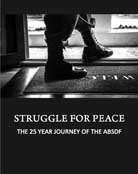The Struggle for Peace editorial
The Journey of the All Burma Students Democratic Front
By Nerea Bilbatua
Making war is often easier than making peace. After decades of violent conflict the possibility of peace, even if is distant and fragile, raises numerous questions and doubts. At the same time a peace process presents to those armed groups engaged in it with opportunities that had previously seemed inconceivable: the possibility of (perhaps) achieving (some of) the objectives that prompted them to take up the arms on the first place; the possibility of becoming something different; the possibility of coming back home after decades being away.
How can an organization committed to conflict transformation support this process?
There is not one single answer. The different responses need to be based on strong analysis, on dialogue, on respect and recognition, and on imagination.
One of the methodologies used by the Centre for Peace & Conflict Studies (CPCS) as part of its engagement with the Myanmar peace process has been what we call “Peace History”.
The All Burma Students Democratic Front (ABSDF) members like to describe themselves as “the only students’ army in the world “. ABSDF was formed in November 1988 after the Burmese military government crackdown in August 1988 when students lead peaceful demonstrations demanding democracy and human rights. Since then, ABSDF has operated in the border areas, often in alliance with different ethnic armed groups.
In 2012 the Myanmar Government approached the ABSDF as part of its broader peace process and offered to engage in negotiations with them. Upon recommendation from other armed groups, the ABSDF turned to CPCS and requested training in peacebuilding. It was only one year later, after trust had been built between CPCS and the ABSDF that the Peace History project started, and only as part of wider cooperation with the ABSDF, which included trainings and workshops to analyse the reforms taking place inside Myanmar.
In December 2012 some of the ABSDF leadership were allowed to briefly return to Myanmar for the first time in more than two decades. This trip aroused numerous questions: what did people inside the country know about them? How could they share the knowledge gained in the last 25 years? What did “coming back with dignity” mean? What role could the ABSDF play in a democratic Myanmar? These were all key questions that reflected the moment of transformation the ABSDF was experiencing. The Peace History project tried to help them with finding the answers.
Peace History assumed that by engaging in a series of indepth conversations with ABSDF members, by providing them with physical and symbolic safe spaces where they could reflect not just about their current situation, but about their lives, their learning, their joys and fears, about the decisions they have made that have brought them to the peace process, we could capture the intersections between personal stories and historic events; we could capture both a personal and organizational journey. Through Peace History we tried to facilitate a shift that would help the ABSDF men and women move from a narrative of war to a narrative of peace; that would help them in thinking about a future without war, and about the role they could play in it.
Our departure point was the understanding that the relationship between the narrative and truth is complex; stories are not pure fact, nor pure fiction, but by telling them persons can revisit their past and envision their future. Oral history and storytelling and their links with peacebuilding has had a strong influence in the project*, as it had transitional justice and the reflections around the links between memory(ies), truth(s) and reconciliation** .
An element that permeated the project was the understanding that the ABSDF members were its protagonists, not CPCS. They were telling their story; they were sharing their lives with us, and through us with a wider audience. They were telling us things that had never told before. This was not CPCS’ moment – this was ABSDF’s moment.
Whilst the Peace History project required a high degree of trust between participants, working together and trusting each other did not mean a blind, unquestioning relationship with the ABSDF. It did not mean glorifying the armed struggle either.
Through our collaborative Peace History project we at CPCS have learned that just as the responses to war have changed over time, we, as peacebuilders, need to be better at unpacking the processes (both individual and organisational) leading to peace; we need to understand that peace is both a personal journey and an organisational one, and we need to be able to intervene at these different levels. We also need to capture all the dimensions of conflict: its ugliness and the diverse learning that it might bring, the personal losses and gains.
We have learned that these reflective spaces are spaces of transformation – spaces where changes happen. Where the realization of the presence of “friends among enemies, and enemies among friends” takes place.
After months of talks in August 2013, the ABSDF and Myanmar Government signed two ceasefire agreements, just when the 25th anniversary of the 8.8.88 Revolution was being celebrated.
Struggle for Peace: The 25 year journey of the ABSDF can be downloaded in either English or Burmese here.
References:1. Senehi (2002), Chaitin (2003), INCORE (2011) 2. CNRR (2009), Martin Beristain/Hegoa (2000), Proyecto REHMI (1996)
This editorial was written for The Action Support Centre – an African regional hub of a global network of organisations and individuals committed to transforming conflict.

